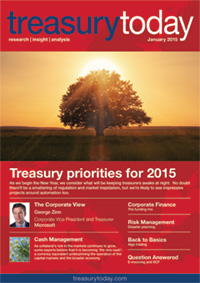Contents
- Editorial
- Treasurers behaving badly
- Question Answered
- Question Answered: E-invoicing evolution
- Market View
- Lower oil price to boost EUR/USD?
- Insight & Analysis
- Treasury in 2015: regulation, trepidation and the quest for automation
- Corporate Finance
- In the mix: corporate funding sources
- The Corporate View
- Corporate View: George Zinn, Microsoft
- The Bigger Picture
- J.P. Morgan: the most powerful man in America
- Risk Management
- When the balloon goes up
- Cash Management
- Collateral: the $4 trillion question
- Back to Basics
- Algo trading: for a few dollars more
Editorial
Treasurers behaving badly
At the start of a New Year, it’s traditional to review our priorities and path for the future. We often think about what we’d like to achieve and what we can do better over the next 12 months – both in a personal and professional capacity. But to make this review a truly useful process, it’s important to take a ‘warts and all’ approach. Frequently, the biggest mistake people, and companies, make when looking to improve their situation is sugar-coating their current predicament or refusing to fully acknowledge their weaknesses.
These kind of mental biases affect every decision that we make, whether we recognise it or not. And when it comes to financial decision-making, cognitive and emotional influences can be so strong as to distort markets – the study of this effect is called ‘behavioural finance’. Of course, you might not think that, as a trained finance professional, these kinds of biases would affect you, but remember that these are innate tendencies, not conscious behaviours.
Take prospect theory, for instance. This outlines how human beings value gains and losses differently and will take decisions on perceived gains rather than perceived losses. So, if a treasurer is given two equal choices – such as the opportunity to invest in a fund, but one is expressed in terms of possible gains and the other in potential losses – they would most likely choose the former.
Experts in behavioural finance believe there to be over 120 such biases which affect the way we make investment decisions. Herd mentality is a well-known one; where we follow what our peers are doing simply because, well, everyone else is doing it. Many will also be familiar with the dangers of hindsight bias and overconfidence when investing. There are other, less obvious, tendencies that many of us harbour, however, which might make you think twice about whether your investment decisions are truly rational. Take confirmation bias for example. This involves being receptive to information which affirms your ideas and confirms your beliefs, while disregarding or devaluing contradictory information. The best example of this is the Dot-Com Boom – despite repeated warnings from analysts, many investors simply carried on regardless; a mindset that former Federal Reserve Chairman Alan Greenspan memorably described as “irrational exuberance”.
Another interesting psychological quirk is outcome bias. This is the tendency to base your investment decisions on previous outcomes, such as past returns, as opposed to thoroughly examining the reasons why the outcome was positive or negative. Ring any bells?
Of course, behavioural finance is by no means an exact science. But it does provide an interesting complement to traditional financial theory that strategic treasurers may want to bear in mind when planning for the year ahead.


